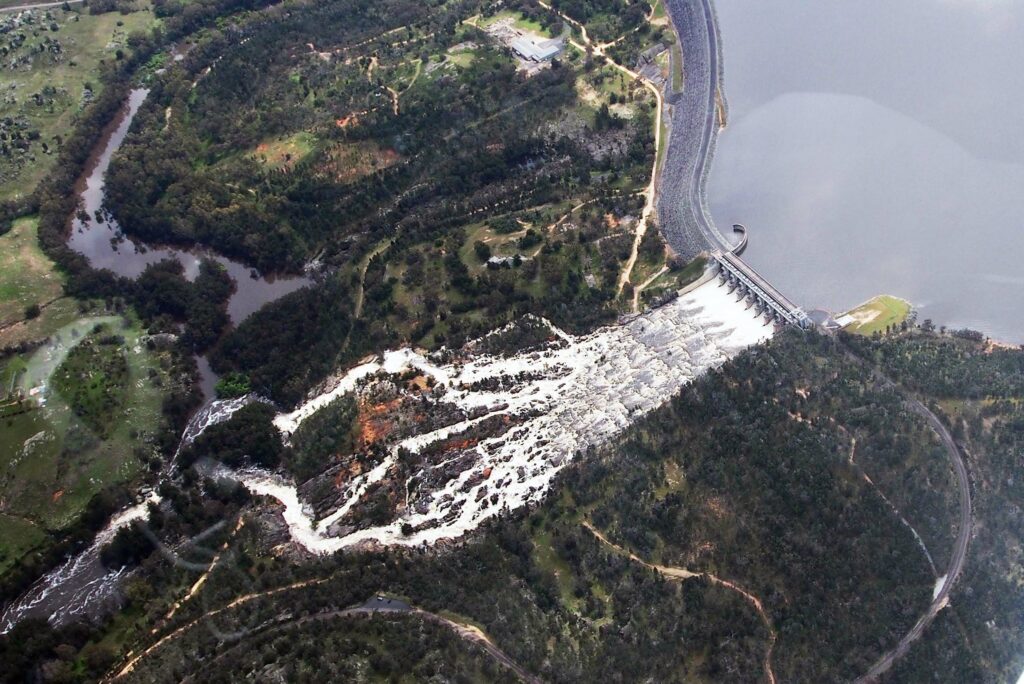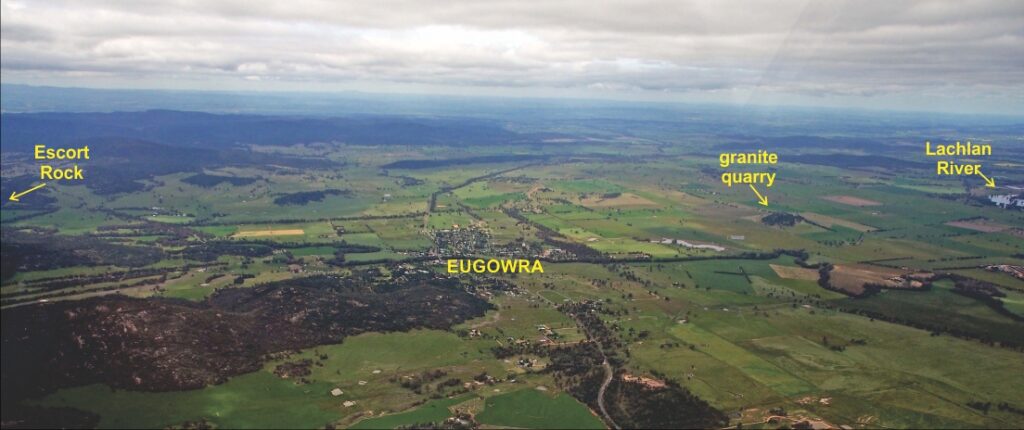
Brad Pillans, Director, National Rock Garden
Published in the National Rock Garden Newsletter No. 24, December 2022
On 16 October, my son, Geoff, and I flew from Canberra to Parkes (and back) to visit the Parkes Aviation Museum. Geoff is a pilot and we hired a small plane for the day, which has the advantage that you can choose your own flight path and altitude. October was wet and I was interested to see the landscape from the air. We flew over Lake George—plenty of water there—then headed northwest towards Parkes, flying over Wyangala Dam (overflowing), Eugowra (not yet flooded) and Forbes (already inundated by the Lachlan River). After lunch at the Aviation Museum, we flew to Cootamundra, then home via Burrinjuck Dam (also overflowing).

Knowing that we had a rock coming from Eugowra, I asked Geoff to do a couple of passes over the town and captured the image below, which shows the location of the granite quarry, about 3 km south of the town, and north of the flooded Lachlan River.
Escort Rock, 4 km north of Eugowra, was the site of Australia’s most famous gold robbery. About 5pm, on Sunday 15 June 1862, a Cobb & Co coach from Forbes, carrying a driver, a police escort of four and a large amount of gold, cash and other mail, was attacked at what is now known as Escort Rock.
Frank Gardiner’s gang of bushrangers—Ben Hall and Johnny Gilbert among them—lay in wait behind large granite boulders (Eugowra Granite, of course) after they had blocked the road with commandeered bullock wagons. This forced the coach to slow and, as it passed, the gang opened fire, wounding two of the police officers. The frightened horses bolted and the coach overturned. The bushrangers then ransacked the coach and made off with 2,719 ounces of gold and £3,700 in cash, packed on one of the coach horses. That much gold, some of which was never recovered, would be worth nearly $7 million at today’s gold prices! You can read the story of the Eugowra Rocks robbery and see a picture of Escort Rock on the A guide to Australian bushranging website.
A long-time friend of mine, Peter Browning, recently told me a family story about Escort Rock: His sister, Helen, who lives nearby, took her grand-daughter to see the location of the robbery, where there are now facilities, etc. After hearing the story, the grand-daughter declared that it was so lovely for the locals to have installed swings for the bushrangers to play on whilst waiting for the coach!

What happened to Frank Gardiner?
According to the Australian Dictionary of Biography, after the gold robbery, Frank Gardiner remained at large until February 1864, when he was arrested in Queensland where he had been living with his mistress, Kate Brown. He was given a cumulative sentence of thirty-two years’ hard labour. In 1874, following petitions to the NSW Governor, Gardiner was released from jail, subject to his exile from Australia. This decision provoked a public controversy with petitions, counter-petitions and violent debates in the NSW Legislative Assembly and led to the fall of the NSW government.
On 27 July 1874, Gardiner embarked for Hong Kong and by February 1875 was in San Francisco where he ran the Twilight Saloon. The press continued to note his activities, including his death in Colorado about 1903, but most reports were unsubstantiated. Source: https://adb.anu.edu.au/biography/gardiner-francis-frank-3589


